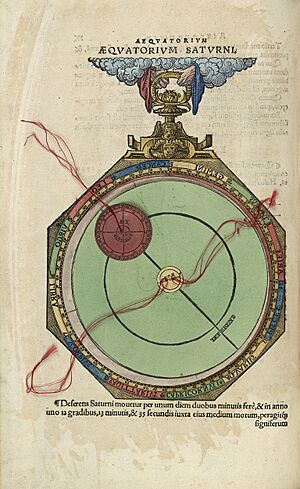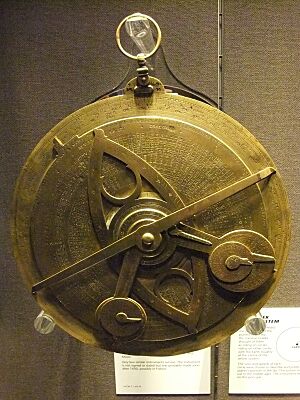Equatorium facts for kids

An equatorium is an old tool used in astronomy. Think of it like a special calculator! It helped people find where the Moon, Sun, and planets would be in the sky. It did this using a clever geometric model, without needing complicated math.
Contents
History of the Equatorium
People have been interested in tracking planets for a very long time.
Early Ideas
In the 300s AD, a mathematician named Theon of Alexandria drew diagrams. These diagrams helped figure out where planets were based on an old idea called Ptolemy's epicycle theory.
Later, in the 400s AD, a scholar named Proclus wrote about how to build a solar equatorium. This was a tool specifically for tracking the Sun. He even gave instructions on how to make it from wood or metal.
Planetary Equatoriums
The first known descriptions of tools that could track *all* the planets came much later. In the early 1000s, a text by Ibn al‐Samḥ described one. Another description came from al-Zarqālī around 1080. These ideas were collected in a famous Spanish book called Libros del saber de astronomia (Books of the Knowledge of Astronomy) in the 1200s.
In Europe, the first clear description of building an equatorium was by Campanus of Novara. This was around 1261 to 1264. His tool looked a bit like an astrolabe and had parts that could be moved.
Different Types of Equatoriums
The idea of the equatorium didn't stop in the 11th century. It inspired new and more complex tools.
The Albion
One such invention was "The Albion," created by Richard of Wallingford in the early 1300s. The Albion was much more advanced than a simple equatorium. It could do many things, like calculate planet positions and even predict when eclipses would happen!
This instrument was very complex. It had 18 different scales, making it quite a challenge to use. Today, there's still some debate about its exact history. The only old Albion found doesn't have a name or any marks on it.
Astrolabe Versus Equatorium
The equatorium actually grew out of an older tool called the astrolabe. The astrolabe has been around since about 220 BC.
What They Do
The main difference between them is their purpose:
- An astrolabe helps you measure the time and the position of the Sun and stars right where you are, at that moment.
- An equatorium is used to figure out where planets and other celestial bodies were in the past, or where they will be in the future. It does this based on the old planetary theories of Ptolemy.
How Equatoriums Were Used
Equatoriums could be specially set up for different celestial bodies.
Tracking Planets
There were settings for the Moon, the stars, and even the Sun. In Ptolemy's view of the universe, the Earth was at the center, and the Sun was considered a "planet." So, the equatorium could track the Sun's position too.
Astronomers could use one instrument to do many things. This was very helpful because they believed the Earth was the center of the solar system.
Saving Time
Using an equatorium saved a lot of time! To calculate a planet's position using old tables, it could take at least 15 minutes for each one. If someone wanted to create a horoscope (which needed the positions of seven different objects), it could take almost two hours of manual calculation! The equatorium made this much faster.
See also
- Antikythera mechanism
- Armillary sphere
- Astrarium
- Astrolabe
- Astronomical clock
- Orrery
- Planetarium
- The Equatorie of the Planetis
- Torquetum


